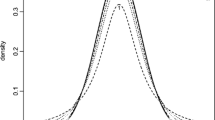Abstract
This article considers the problem of power and sample size calculations for normal outcomes within the framework of multivariate linear models. The emphasis is placed on the practical situation that not only the values of response variables for each subject are just available after the observations are made, but also the levels of explanatory variables cannot be predetermined before data collection. Using analytic justification, it is shown that the proposed methods extend the existing approaches to accommodate the extra variability and arbitrary configurations of the explanatory variables. The major modification involves the noncentrality parameters associated with the F approximations to the transformations of Wilks likelihood ratio, Pillai trace and Hotelling-Lawley trace statistics. A treatment of multivariate analysis of covariance models is employed to demonstrate the distinct features of the proposed extension. Monte Carlo simulation studies are conducted to assess the accuracy using a child’s intellectual development model. The results update and expand upon current work in the literature.
Similar content being viewed by others
References
Glueck D.H., Muller K.E. (2003) Adjusting power for a baseline covariate in linear models. Statistics in Medicine 22:2535–2551
Keselman H.J. (1998) Testing treatment effects in repeated measures designs: An update for psychophysiological researchers. Psychophysiology 35:470–478
Keselman H.J., Algina J., Kowalchuk R.K. (2001) The analysis of repeated measures designs: a review. British Journal of Mathematical and Statistical Psychology 54:1–20
McKeon J.J. (1974) F approximations to the distribution of Hotelling’s T20. Biometrika 61:381–383
Mendoza J.L., Stafford K.L. (2001) Confidence interval, power calculation, and sample size estimation for the squared multiple correlation coefficient under the fixed and random regression models: A computer program and useful standard tables. Educational and Psychological Measurement 61:650–667
Muirhead R.J. (1982) Aspects of Multivariate Statistical Theory. Wiley, New York, NY
Muller K.E., Peterson B.L. (1984) Practical methods for computing power in testing the multivariate general linear hypothesis. Computational Statistics and Data Analysis 2:143–158
Muller K.E., LaVange L.M., Ramey S.L., Ramey C.T. (1992) Power calculations for general linear multivariate models including repeated measures applications. Journal of the American Statistical Association 87:1209–1226
O’Brien R.G., Muller K.E. (1993) Unified power analysis for t-tests through multivariate hypotheses. In: Edwards L.K. (ed) Applied Analysis of Variance in Behavioral Science. Marcel Dekker, New York, NY, pp 297–344
O’Brien R.G., Shieh G. (1992) Pragmatic, unifying algorithm gives power probabilities for common F tests of the multivariate general linear hypothesis. In paper presented at the Annual Joint Statistical Meetings of the American Statistical Association, Boston, Massachusetts.
Pillai K.C.S. (1956) On the distribution of the largest or the smallest root of a matrix in multivariate analysis. Biometrika 43:122–127
Pillai K.C.S., Samson P. Jr. (1959) On Hotelling’s generalization of T2. Biometrika 46:160–168
Rao C.R. (1951) An asymptotic expansion of the distribution of Wilks’ criterion. Bulletin of the International Statistics Institute 33:177–180
Rencher A.C. (1998) Multivariate Statistical Inference and Applications. Wiley, New York, NY
Roy S.N. (1953) On a heuristic method of test construction and its use in multivariate analysis. Annals of Mathematical Statistics 24:220–238
Sampson A.R. (1974) A tale of two regressions. Journal of the American Statistical Association 69:682–689
SAS Institute (2003) SAS/IML software: usage and reference. Version 8, Carey, NC.
Shieh G. (2003) A comparative study of power and sample size calculations for multivariate general linear models. Multivariate Behavioral Research 38:285–307
Timm N.H. (2002) Applied Multivariate Analysis. Springer, New York, NY
Author information
Authors and Affiliations
Corresponding author
Additional information
The author wishes to thank the associate editor and the referees for comments which improve the paper considerably. This research was partially supported by a grant from the Natural Science Council of Taiwan.
Rights and permissions
About this article
Cite this article
Shieh, G. Power and sample size calculations for multivariate linear models with random explanatory variables. Psychometrika 70, 347–358 (2005). https://doi.org/10.1007/s11336-003-1094-0
Published:
Issue Date:
DOI: https://doi.org/10.1007/s11336-003-1094-0




